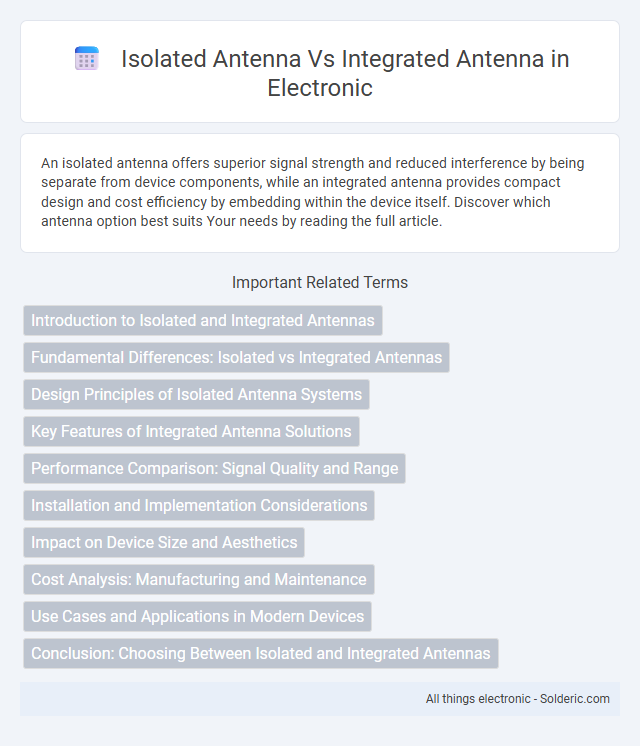An isolated antenna offers superior signal strength and reduced interference by being separate from device components, while an integrated antenna provides compact design and cost efficiency by embedding within the device itself. Discover which antenna option best suits Your needs by reading the full article.
Comparison Table
| Feature | Isolated Antenna | Integrated Antenna |
|---|---|---|
| Design | Separate component, standalone | Built into device circuitry or PCB |
| Performance | Higher gain and range | Lower gain due to space constraints |
| Size | Bulky, requires additional space | Compact, saves device space |
| Cost | Higher, due to separate parts and assembly | Lower, integrated in manufacturing |
| Installation | Requires manual installation | Pre-installed, plug-and-play |
| Interference | Less prone due to isolation | Higher risk of signal interference |
| Applications | Outdoor, long-range, specialized use | Mobile devices, IoT, compact electronics |
Introduction to Isolated and Integrated Antennas
Isolated antennas operate independently from other circuit components, providing enhanced signal clarity and reduced interference due to physical separation. Integrated antennas are built directly into devices, offering compact design and cost efficiency but may experience increased noise from surrounding electronics. Choosing between isolated and integrated antennas depends on factors like device size, performance requirements, and environmental conditions.
Fundamental Differences: Isolated vs Integrated Antennas
Isolated antennas are standalone components designed to operate independently, providing enhanced signal strength and reduced interference by physically separating the antenna from other circuitry. Integrated antennas, embedded within the device's PCB or housing, offer compactness and cost efficiency but may experience performance limitations due to proximity to other electronic components and limited size. The fundamental difference lies in the trade-off between superior signal isolation and integration convenience, impacting overall device design and wireless communication performance.
Design Principles of Isolated Antenna Systems
Isolated antenna systems are designed to minimize mutual coupling by physically separating antennas and employing shielding techniques, which improves signal integrity and reduces interference. The design principles emphasize spatial isolation, ground plane optimization, and the use of decoupling structures like electromagnetic bandgap materials and neutralization lines. These methods enhance the antenna's radiation efficiency and bandwidth compared to integrated antenna designs, where shared components increase coupling effects.
Key Features of Integrated Antenna Solutions
Integrated antenna solutions offer compact design and improved signal integrity by embedding the antenna directly into the device's PCB, reducing size and enhancing portability. These antennas provide better resistance to environmental interference and ensure consistent performance across multiple frequency bands. Integration simplifies manufacturing processes and reduces overall product cost by eliminating the need for separate antenna components.
Performance Comparison: Signal Quality and Range
Isolated antennas typically offer superior signal quality and extended range due to reduced electromagnetic interference and optimized placement, enhancing overall device connectivity. Integrated antennas, while more compact and cost-effective, often face performance limitations caused by proximity to other electronic components and structural materials that can attenuate signals. Choosing between isolated and integrated antennas depends on the specific application requirements for signal clarity and transmission distance.
Installation and Implementation Considerations
Isolated antennas require careful mounting to avoid interference and ensure optimal signal quality, often needing external brackets or mounts that increase installation complexity and space usage. Integrated antennas simplify implementation by being built into the device, reducing the need for additional hardware and minimizing signal loss due to cable connections. Installation of integrated antennas often results in faster deployment and lower maintenance, but may limit antenna size and performance compared to isolated alternatives.
Impact on Device Size and Aesthetics
Isolated antennas typically occupy more physical space, leading to larger device dimensions, while integrated antennas are embedded within the device's structure, enabling more compact and sleek designs. The use of integrated antennas enhances aesthetics by minimizing external protrusions, contributing to a seamless and modern appearance. Your choice between isolated and integrated antennas directly influences both the size and visual appeal of the final product.
Cost Analysis: Manufacturing and Maintenance
Isolated antennas typically incur higher manufacturing costs due to the need for separate components and specialized housings, whereas integrated antennas reduce expenses by combining antenna elements directly into devices, streamlining assembly processes. Maintenance costs for isolated antennas can escalate because of additional hardware susceptibility to environmental damage, while integrated antennas often feature enhanced durability and fewer failure points, lowering long-term upkeep expenses. You can optimize your budget by evaluating these cost differences in relation to your product's design and operational requirements.
Use Cases and Applications in Modern Devices
Isolated antennas offer superior signal clarity and are preferred in high-performance applications such as professional communication equipment and advanced IoT devices where minimal interference is crucial. Integrated antennas are commonly used in compact smartphones, wearables, and consumer electronics to save space and reduce manufacturing costs while maintaining adequate connectivity. The choice between isolated and integrated antennas depends on device size constraints, signal quality requirements, and specific use case scenarios across modern wireless technologies.
Conclusion: Choosing Between Isolated and Integrated Antennas
Isolated antennas offer superior signal quality and reduced interference due to physical separation from other components, making them ideal for high-performance applications. Integrated antennas save space and reduce manufacturing costs, fitting well in compact devices where design constraints are critical. Your choice depends on balancing performance needs with device size and budget considerations.
isolated antenna vs integrated antenna Infographic

 solderic.com
solderic.com